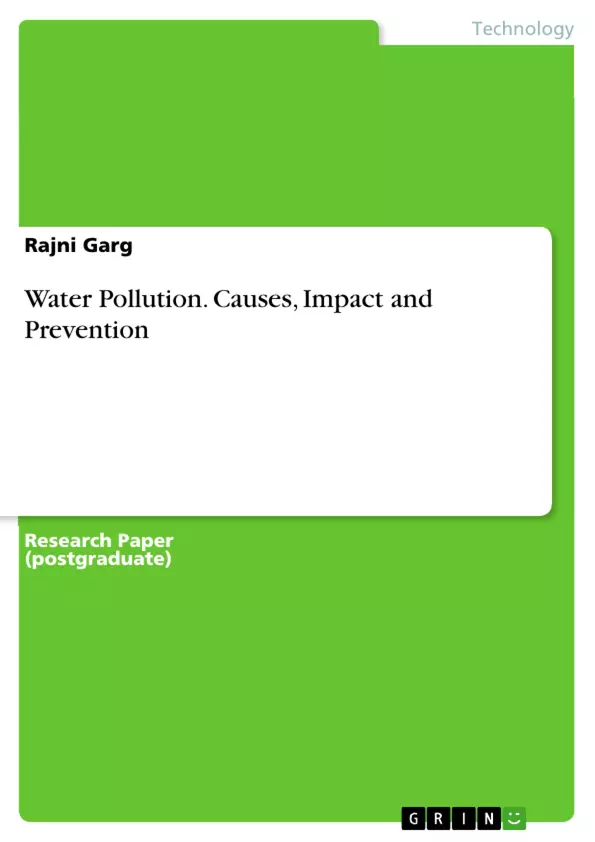This paper is primarily focused on the creation of a wide range of novel anti-pollution and environmental remediation techniques along with introducing the issue of water pollution.
One issue that contributes to the poisoning of water sources is the simplicity with which toxic substances from cities, towns, and factories may dissolve and combine with water. Injurious substances, most frequently chemicals or microbes, can pollute a stream, river, lake, ocean, aquifer, or other body of water. As a result, both humans and the ecosystem are harmed by the declining quality of the water. It is presently illegal for industrial and agricultural enterprises to dump pollutants into bodies of water like lakes, streams, and rivers due to the rules in place in many countries. Treatment facilities ensure that the water we drink is free of any dangerous toxins in the interim.
Table of Contents
- 1. Introduction
- 2. Categories of Pollutants
- Single point of origin
- Diffused origin
- Transboundary
Objectives and Key Themes
This paper aims to introduce the issue of water pollution and explore a wide range of novel anti-pollution and environmental remediation techniques. The paper focuses on the causes, impact, and prevention of water pollution, highlighting the urgency of addressing this global crisis.
- Causes of Water Pollution (point and non-point sources)
- Types of Water Pollutants (chemicals, microorganisms, nutrients)
- Impact of Water Pollution on human health and the environment
- The global freshwater crisis and its connection to pollution
- Potential solutions and preventative measures
Chapter Summaries
1. Introduction: This chapter introduces the pervasive problem of water pollution, emphasizing water's role as a universal solvent and its susceptibility to contamination from various sources, including cities, towns, and factories. It highlights the detrimental effects of polluted water on human health and the environment, citing statistics on the global freshwater crisis and the disproportionate impact on vulnerable populations. The chapter also introduces PFAS, a particularly concerning pollutant found in drinking water, and underscores the scarcity of readily available freshwater resources.
2. Categories of Pollutants: This chapter categorizes water pollutants based on their origin: point source pollution (from identifiable sources like factories and wastewater treatment plants), non-point source pollution (from diffuse sources like agricultural runoff and storm drains), and transboundary pollution (crossing international borders). It details the significant contribution of agriculture to water pollution due to fertilizer and pesticide use, as well as the widespread issue of untreated wastewater discharge. The chapter also highlights the challenges in controlling non-point source pollution and the significant impact of both surface and groundwater contamination.
Keywords
Water pollution, freshwater crisis, point source pollution, non-point source pollution, transboundary pollution, pollutants, agricultural runoff, wastewater, PFAS, environmental remediation, pollution prevention.
Frequently Asked Questions: Comprehensive Language Preview on Water Pollution
What is the overall focus of this document?
This document provides a comprehensive overview of water pollution, including its causes, impacts, and potential solutions. It explores various categories of pollutants, their origins, and the challenges in addressing this global crisis, particularly focusing on the scarcity of freshwater resources and the disproportionate impact on vulnerable populations.
What are the main topics covered in the Table of Contents?
The document covers an introduction to water pollution, a detailed categorization of pollutants (single point, diffused, and transboundary origins), objectives and key themes, chapter summaries, and finally, keywords related to the subject matter.
What are the key objectives and themes explored in the document?
The main objectives are to introduce the issue of water pollution and explore novel anti-pollution and environmental remediation techniques. Key themes include the causes and impact of water pollution (from point and non-point sources), different types of water pollutants (chemicals, microorganisms, nutrients), the global freshwater crisis, and potential solutions and preventative measures.
What are the main points discussed in Chapter 1: Introduction?
Chapter 1 introduces the widespread problem of water pollution, emphasizing water's vulnerability to contamination from diverse sources. It highlights the negative effects on human health and the environment, citing statistics on the global freshwater crisis and its unequal impact. The chapter also introduces PFAS as a significant pollutant and stresses the limited availability of freshwater.
What are the main points discussed in Chapter 2: Categories of Pollutants?
Chapter 2 categorizes water pollutants based on their origin: point source (identifiable sources like factories), non-point source (diffuse sources like agricultural runoff), and transboundary pollution. It details agriculture's significant contribution due to fertilizers and pesticides, and the problem of untreated wastewater. The chapter also highlights the challenges in managing non-point source pollution and the impact of both surface and groundwater contamination.
What keywords are associated with this document?
Keywords include: Water pollution, freshwater crisis, point source pollution, non-point source pollution, transboundary pollution, pollutants, agricultural runoff, wastewater, PFAS, environmental remediation, pollution prevention.
- Quote paper
- Dr. Rajni Garg (Author), 2022, Water Pollution. Causes, Impact and Prevention, Munich, GRIN Verlag, https://www.grin.com/document/1309155



